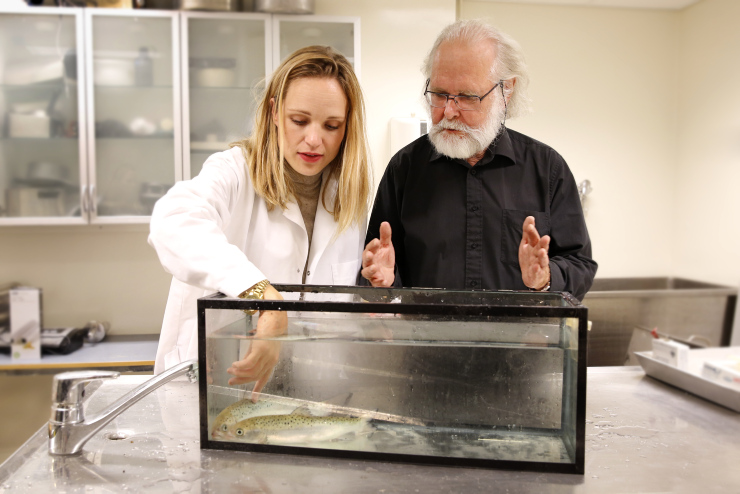During the Transatlantic Science Week in Boston this November, professor Nils Chr. Stenseth at the Department of Biosciences, University of Oslo (UiO), who is head of CEES and NorMER), presented the work of both centres.
Fishing pressure causes evolution

Stenseth started by changing the title of his presentation from Sustainable Aquatic Food Production Under Climate Change to Sustainable Aquatic Food Production Under Anthropogenic Change – change caused by human activity – since investigating the variety of ways in which humans affect the environment and natural resources is a key interest for him and his colleagues.
For example, Stenseth referred to how high fishing pressure causes cod to become steadily smaller and mature at an earlier stage – the fishing pressure causes the fish to evolve. He pointed out that their research helps reduce uncertainty in the management of this fish stock.
Young researchers play a key role
Stenseth drew special attention to the contributions made by young researchers in the centres he is heading. ‘Many of the articles published by NorMER were initiated by young researchers. We are grateful to them for our success,’ he said, emphasizing that the Nordic centre NorMER is a window on the rest of the world.
In the project GreenMAR which is partly funded by NordForsk, Nordic researchers are involved in interdisciplinary collaboration with colleagues from the Netherlands, Russia and the USA.
‘Green growth can only be achieved through collaboration across disciplines and cultures.’ Stenseth declared.
‘We need to understand how people and nature with its resources are interlinked and affect each other mutually in a world marked by more uncertainty and external influences, such as climate change.’
Anne Maria Eikeset is one of the young researchers in Stenseth’s research group. She links evolution, economics and biology to learn more about what is needed to manage fish stocks optimally. Such knowledge can be used to support public decision-making.
Evolution protects against collapse
It was Eikeset whose PhD showed how evolution is helping ensure that Atlantic cod in the Barents Sea mature at an earlier stage when the largest cod are being caught.
‘Its life cycle speeds up to let it produce offspring before it is caught and to prevent the fish stock from collapsing. It lives faster and dies younger,’ Eikeset explains. She showed how fishing less could pay off in the form of larger fish and a healthier stock, and thus a better yield.
‘For my PhD I obtained large amounts of surveillance data from the Institute of Marine Research and public tables on catch volumes. I used these data to produce a model showing how much evolution is needed to explain the data.’
Uses the model on other species
Now Eikeset has used the model that she developed based on Barents Sea cod to simulate how so-called fishery-induced evolution affects other fish species for which the same type of data are not available.
Working with a Canadian researcher and Professor Stenseth, she has studied Atlantic cod (Gadus morhua) living outside the Barents Sea, lake whitefish (Coregonus clupeaformis) and yellow perch (Perca flavescens).
‘We have seen that the population’s growth rate is a factor that affects sustainability and catch volumes, and it is affected by evolutionary change. When there is little fishing, evolution has only a minor effect on the growth rate of the stock. When fishing pressure increases, however, the evolutionary changes and the growth rate of cod and whitefish increase, since early reproduction now pays off. Such changes ensure new offspring, thus reducing the risk of a collapse in the stock,’ she explains.
‘It is important to keep in mind that heavy fishing may have long-term negative effects, even after a moratorium – a ban on fishing. Even though fishing has stopped, such evolutionary changes are slow and we can see that the stock is slow to recover.’
The precautionary principle is important
For yellow perch they could see a different pattern.
‘Yellow perch already has a high growth rate, meaning a faster life cycle with early maturation and a shorter life, so it did not have the same evolutionary response to fishing. It has already adapted to high mortality and has less space to adapt to further fish mortality, and is therefore at a higher risk of collapse at heavy fishing.’ So what is the practical importance of these research results? ‘We can obtain better knowledge on the factors that cause some species to succeed better than others, when fishing ought to stop and why some stocks fail to recover as quickly as we assume, even after a ban. This and similar models and studies indicate that the precautionary principle should be applied more strictly than before,’ Eikeset concludes.
CEES, NorMER and GreenMAR
- Centre of Ecological and Evolutionary Synthesis (CEES) is a Centre of Excellence in Research (SFF) funded partly by the Research Council of Norway
- Nordic Centre for Research on Marine Ecosystems and Resources under Climate Change (NorMER) is a Nordic Centre of Excellence (NCoE) partly funded by NordForsk
- Green Growth Based on Marine Resources: Ecological and Socio-Economic Constraints (GreenMAR) is a project partly funded by NordForsk
